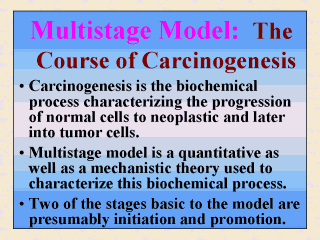| front |1 |2 |3 |4 |5 |6 |7 |8 |9 |10 |11 |12 |13 |14 |15 |16 |17 |18 |19 |20 |21 |review |
 |
Carcinogenesis per
se is referred to as the biochemical process characterizing the transformation of
normal cells to neoplastic cells which may eventually progress into tumor cells. The
multistage model of carcinogenesis is a mechanistic as well as a biomathematical theory
used to characterize this biochemical process. The mechanistic process of carcinogenesis
has been studied rigorously by toxicologists specialized in molecular biology and the
like, beginning at the time when these fields were still in their infancy. Tumor as a human disease, on the other hand, has been recognized for centuries, dating back at least to the description of breast cancer in the Edwin Smith Papyrus (that Ancient Egyptian medical treatise first deciphered by the American Egyptologist Edwin Smith). The notion that exposure to chemicals can induce carcinogenesis is likewise ancient. In fact, cancer epidemiologists are often proud of citing the classic observation made in 1775 by the eminent English physician Percivall Pott, that an unusually high incidence of scrotal cancer was found in patients with a history of employment as chimney sweeps. The overall biochemical and cellular processes for the induction of cancer are thought to be quite complex, in some cases likely involving several stages. Two major carcinogenic stages are generally recognized: an initiation step followed by a promotional process. Chemical carcinogens are often mutagenic, suggesting that they are likely to alter the macromolecule DNA in a manner such that the affected cell would continue to replicate itself and eventually develop into some cancerous tissues. |